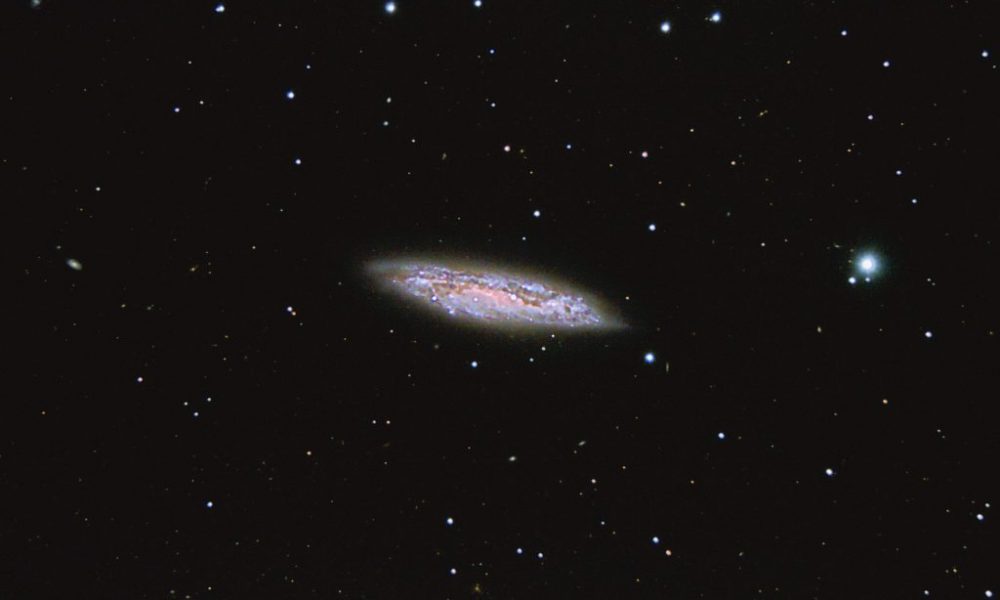Springtime for Galaxies — Lookout Observatory
Dear Lookout Observers,
Our landscape varies with the season. So we get sayings like, “April showers bring May flowers.” But when the whole western United States is in a serious multiyear drought, we may have limited flowers. Our “skyscape” also varies with the season, but it is not affected by droughts. The night sky reliably brings us galaxies every spring. This occurs because from mid-northern latitudes in the springtime the North Galactic Pole is high in the sky to the south most of the night. When you are looking in that direction, you are looking perpendicular to the plane of the Milky Way galaxy. This means you will not see the Milky Way with all it’s stars and glowing gasses in the spring sky, but you also will not be looking through all the obscuring dust that lies throughout much of our galaxy, so you will have a clear view out to distant other galaxies.
Imagine our galaxy is like a dinner plate sitting on a dining room table with a steaming meal spread all across the plate. If you were a small creature in the middle of that steaming meal, and you tried to look at a spider on the wall at table height, you would have a hard time seeing it because of all the steam rising from the meal that you would be trying to look through. But if you looked straight up at a spider on the ceiling overhead, you would have a clear view with little steam to block your view. That’s like looking up toward the North Galactic Pole. That spot is in the constellation Coma Berenices, and the constellation Virgo is just south of there. Some of the largest clusters of galaxies in the universe lie in the direction of Coma Berenices and Virgo, and these and other groups of galaxies are well placed for viewing on spring nights. We can see them without all the dust in our own galaxy getting in the way.
About 16 degrees south of the North Galactic Pole lie two spiral galaxies in Virgo that are just beginning to collide, centered in the first picture. The upper, bluer one (NGC4567) is just bout face on, while the lower, pinker one (NGC4568) is turned at an angle. We can tell they have not fully collided yet because both spirals are still quite symmetrical and undisturbed. Once galaxies interact, they usually become quite distorted. Near the top center of the picture is an elliptical galaxy (NGC4564), and near the bottom center is a dwarf lenticular galaxy (IC3578), and if you look closely you will find many other galaxies (looking like tiny fuzzy spots slightly larger than stars of the same brightness) scattered across the image. Most of these galaxies belong to the Virgo Cluster of galaxies, about 50 to 70 million light years away and containing 1000 to 2000 members.
The second picture is of a galaxy about 24 degrees southwest of the North Galactic Pole in the neighboring constellation of Leo. NGC3628 is a spiral galaxy seen edge on with much obscuring dust and gas along its center line, much like our own Milky Way. It is about 35 million light years distant, or roughly half the distance of the galaxies in the first photo and about twice as large as the largest galaxy in the first photo. It is about the same size of our own Milky Way galaxy. It is a member of a small group of galaxies, including M65 and M66, which lie outside this picture. It shows evidence of past (almost a billion years ago) interaction with another group member because of the disrupted right portion of the central dust lane being split into multiple branches and the extended envelope of brightness around the main parts of the galaxy, suggesting tidal disruption. A very faint dwarf companion galaxy (HKK2009 dJ1120+1332, discovered in 2009) can be seen as a vertical smudge just a bit below the center of this galaxy.
The last picture is of another spring galaxy, M108, that is about 33 degrees northwest of the North Galactic Pole, just below the bowl of the Big Dipper. It is a nearly on edge spiral galaxy with loosely wound spiral arms – in fact, so loose that it is hard to make out the spiral structure in the arms. But it has pretty colors and an interesting structure of dust lanes, so it seemed a good one to end on. Each of these pictures shows galaxies that belong to a different grouping, and our own Milky Way belongs to yet a fourth group called the Local Group. But just as human groups all have larger groups they belong to, all four of these galaxy groups are part of the Virgo Supercluster, a huge gathering of dozens of galaxy groups and clusters about 100 million light years across, all traveling through space together. Wouldn’t it be lovely if all our human groups could also learn to travel together?
Keep looking up,
Carter, (sometime) Resident Astronomer,
Lookout Observatory


